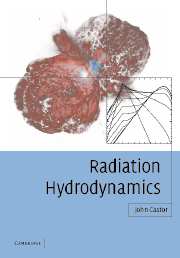Book contents
- Frontmatter
- Contents
- List of figures
- Preface
- 1 Introduction
- 2 A quick review of gas dynamics
- 3 Numerical hydrodynamics
- 4 Description of radiation
- 5 Steady-state transfer
- 6 The comoving-frame picture
- 7 Hydrodynamics with radiation: waves and stability
- 8 Radiation–matter interactions
- 9 Spectral line transport
- 10 Refraction and polarized light
- 11 Numerical techniques for radiation transport
- 12 Examples
- References
- Index
4 - Description of radiation
Published online by Cambridge University Press: 18 February 2010
- Frontmatter
- Contents
- List of figures
- Preface
- 1 Introduction
- 2 A quick review of gas dynamics
- 3 Numerical hydrodynamics
- 4 Description of radiation
- 5 Steady-state transfer
- 6 The comoving-frame picture
- 7 Hydrodynamics with radiation: waves and stability
- 8 Radiation–matter interactions
- 9 Spectral line transport
- 10 Refraction and polarized light
- 11 Numerical techniques for radiation transport
- 12 Examples
- References
- Index
Summary
We turn now to the subject of radiation transport. As much as possible, the present goal is to demystify this subject. Photons are just particles like the others that make up our systems; they just happen to go faster and farther, and are therefore often of special importance in carrying energy and momentum from one place to another. In kinetic theory we introduce the phase-space distribution function for the atoms, develop the theory of the Boltzmann transport equation, and come up with some satisfactory approximate methods for solving it. Radiation transport is exactly the same; the transport equation is about the same, and the approximate methods are about the same as well. The difference is that the subject of radiation transport was elaborated by different people than was kinetic theory, using an entirely different notation, and we have that difference with us today. In the last two or three decades yet another community has joined the discussion of radiation transport, and these are the nuclear engineers, who have evolved a collection of methods for describing neutron transport, methods that are useful for photons as well as neutrons. The present discussion will not attempt to show, Rashomon-like, the same physical concepts from the varied points of view of several disciplines. We will stick with one, mainly the astrophysical notation found, for example, in Mihalas and Mihalas (1984). The elementary definitions of the radiation field quantities are found in many astrophysics books. One good treatment is Mihalas's Stellar Atmospheres (1978), and this is also found in Mihalas and Mihalas (1984).
- Type
- Chapter
- Information
- Radiation Hydrodynamics , pp. 69 - 85Publisher: Cambridge University PressPrint publication year: 2004



